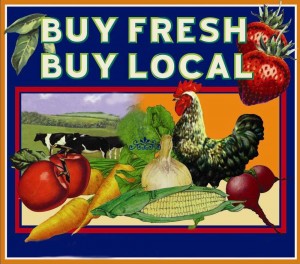 Eating local means more for the local economy. According to a study by the New Economics Foundation in London, a dollar spent locally generates twice as much income for the local economy. When businesses are not owned locally, money leaves the community at every transaction. (reference)
Eating local means more for the local economy. According to a study by the New Economics Foundation in London, a dollar spent locally generates twice as much income for the local economy. When businesses are not owned locally, money leaves the community at every transaction. (reference)
Locally grown produce is fresher. While produce that is purchased in the supermarket or a big-box store has been in transit or cold-stored for days or weeks, produce that you purchase at your local farmer’s market has often been picked within 24 hours of your purchase. This freshness not only affects the taste of your food, but the nutritional value which declines with time.
Local food just plain tastes better. Ever tried a tomato that was picked within 24 hours? ‘Nuff said.
[pro_ad_display_adzone id=”110028″]
Locally grown fruits and vegetables have longer to ripen. Because the produce will be handled less, locally grown fruit does not have to be “rugged” or to stand up to the rigors of shipping. This means that you are going to be getting peaches so ripe that they fall apart as you eat them, figs that would have been smashed to bits if they were sold using traditional methods, and melons that were allowed to ripen until the last possible minute on the vine.
Eating local is better for air quality and pollution than eating organic. In a March 2005 study by the journal Food Policy, it was found that the miles that organic food often travels to our plate creates environmental damage that outweighs the benefit of buying organic. (reference)
Buying local food keeps us in touch with the seasons. By eating with the seasons, we are eating foods when they are at their peak taste, are the most abundant, and the least expensive.
Buying locally grown food is fodder for a wonderful story. Whether it’s the farmer who brings local apples to market or the baker who makes local bread, knowing part of the story about your food is such a powerful part of enjoying a meal.
Local food translates to more variety. When a farmer is producing food that will not travel a long distance, will have a shorter shelf life, and does not have a high-yield demand, the farmer is free to try small crops of various fruits and vegetables that would probably never make it to a large supermarket. Supermarkets are interested in selling “Name brand” fruit: Romaine Lettuce, Red Delicious Apples, Russet Potatoes. Local producers often play with their crops from year to year, trying out Little Gem Lettuce, Senshu Apples, and Chieftain Potatoes.
Supporting local providers supports responsible land development. When you buy local, you give those with local open space – farms and pastures – an economic reason to stay open and undeveloped.
Michael Pollan: Why Eat Local?
A great short 2 minute video baring a few references to “climate change”:
Want to Pick Your Own Food? Find a Pick Your Own Farm Near You!
PICK YOUR OWN.ORG provides local listings of pick your own (also called U-pick or PYO) farms in the United States, Canada, Britain, Australia, New Zealand, South Africa and other countries. There are crop calendars for each local area to tell you what is available to pick throughout the year, local weather forecasts and really easy illustrated directions to show you how to make jam, jelly, salsa, pickles, spaghetti sauce, applesauce, apple butter and 150 other recipes with step-by-step directions to can, freeze, dry or preserve the harvest.
Picking Tips
What to bring
- Pack for a day trip – I always bring snacks, hand towels or disposable wipes and plenty of liquids to drink.
- Include containers for picking and for carrying the fruit home (smaller containers are better for children’s smaller hands), Some farms provide them, but usually for a fee.
- Dress in old clothes and worn athletic shoes; you want to be comfortable and not worried about staining or tearing your clothes! If the ground is wet, it will really ruin any nice shoe, so wear your beat up old ones!
- Wide-brimmed hats help protect you from the summer sun; and in the Fall, extra layers keep you warm. Don’t forget natural sunscreen for the back of your neck and exposed skin.
http://pickyourown.org/pickingtips.htm
Harvest Calendars
Do you have a favourite fruit or vegetable, and you’d love to get it fresh and local, but you don’t know when it is normally harvested in your area? Then you are in luck: these pages link to the world crop harvest calendars. Just click on your US state or country and the link will take you to the crop calendar for your area.
Q – How precise are the calendars?
A – They’re as precise as the weather! Which means, they can normally vary by 1 to 2 weeks. So, to be safe, call the farms 2 weeks before the start of a season for a given crop, according to the calendar for your area!
http://www.pickyourown.org/crop_harvest_calendars
When You Get Home
Please visit our posting on how to Increase The Shelf Life of Your Fruit & Veg..Without Using Toxic Plastic Products to ensure you obtain maximum freshness.
Article Sources:
[pro_ad_display_adzone id=”110027″]






